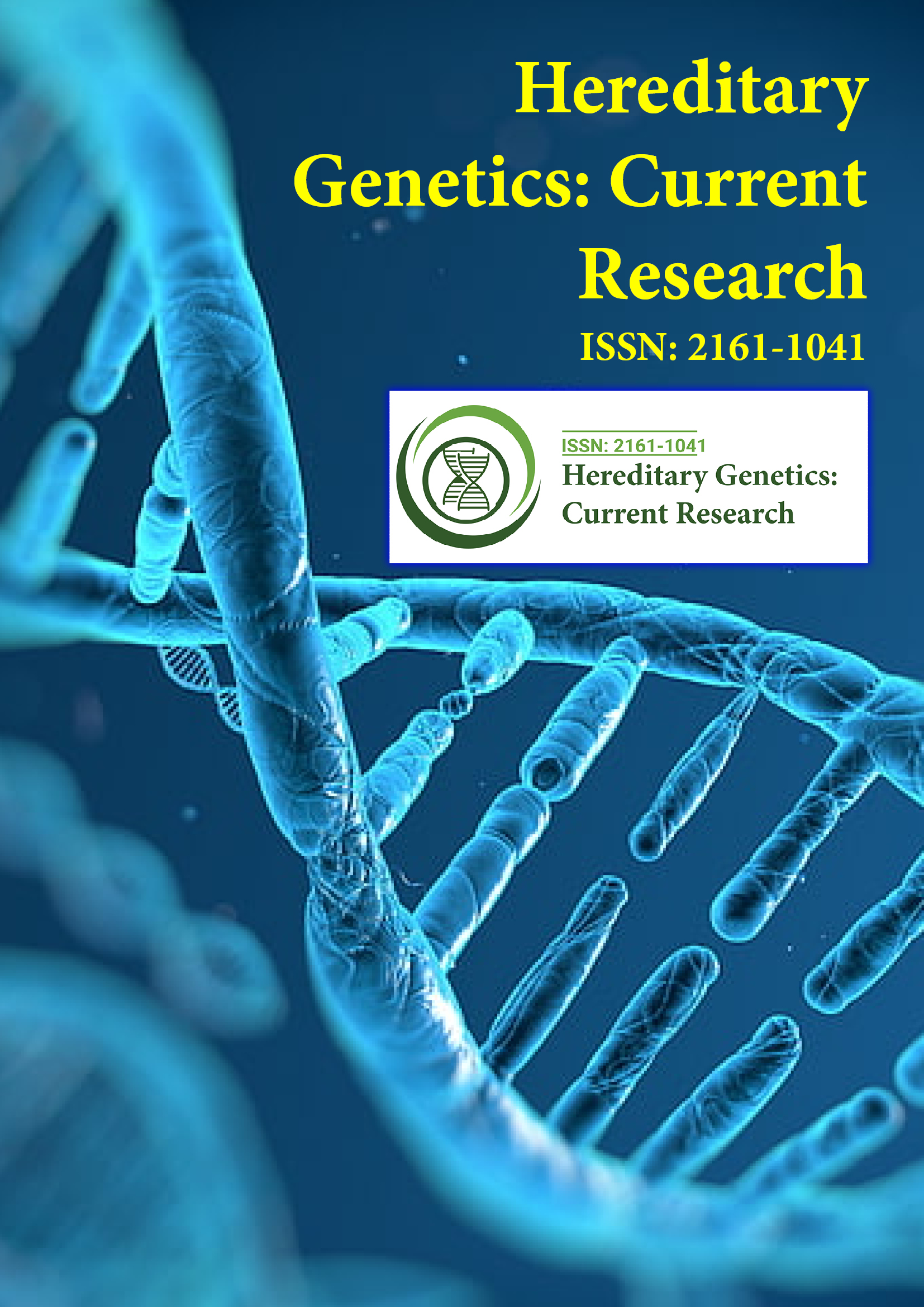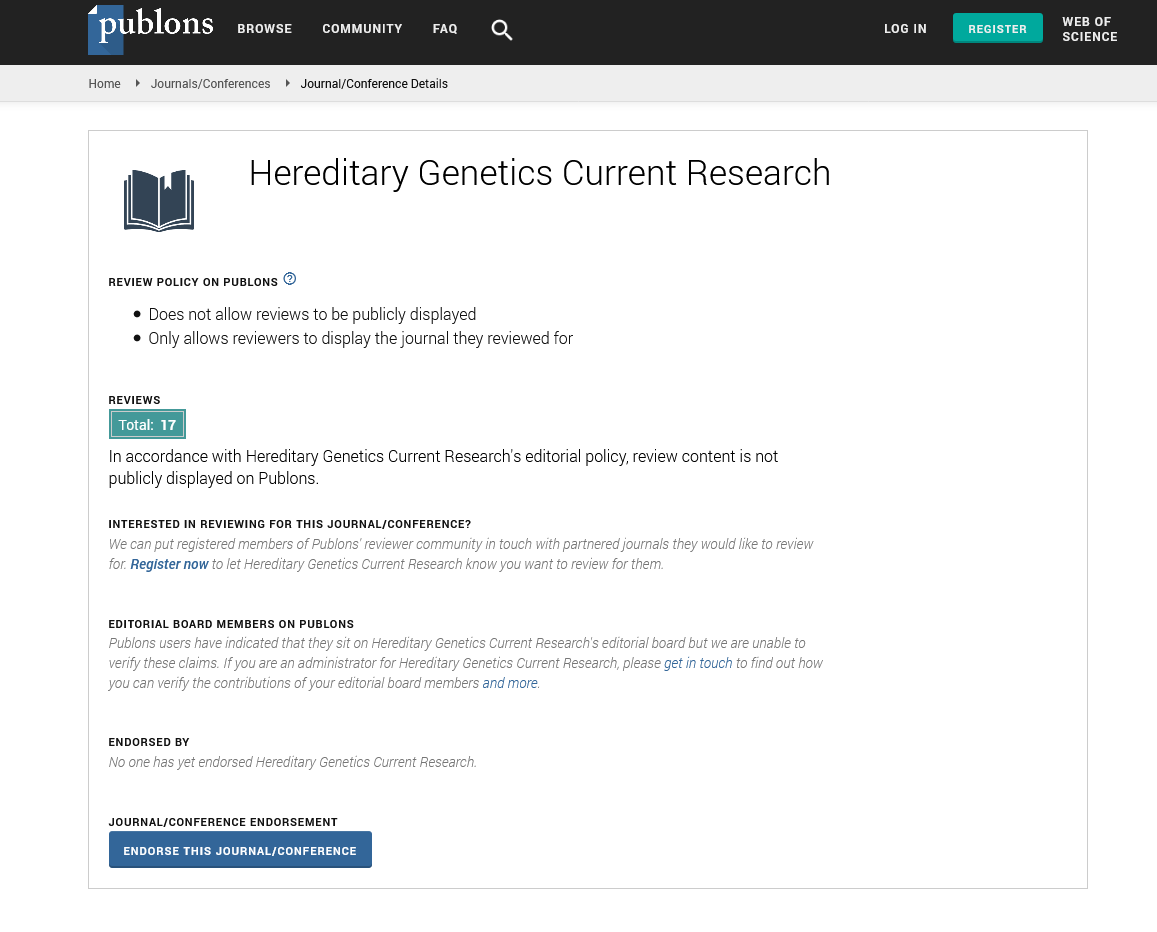Indexed In
- Open J Gate
- Genamics JournalSeek
- CiteFactor
- RefSeek
- Hamdard University
- EBSCO A-Z
- NSD - Norwegian Centre for Research Data
- OCLC- WorldCat
- Publons
- Geneva Foundation for Medical Education and Research
- Euro Pub
- Google Scholar
Useful Links
Share This Page
Journal Flyer

Open Access Journals
- Agri and Aquaculture
- Biochemistry
- Bioinformatics & Systems Biology
- Business & Management
- Chemistry
- Clinical Sciences
- Engineering
- Food & Nutrition
- General Science
- Genetics & Molecular Biology
- Immunology & Microbiology
- Medical Sciences
- Neuroscience & Psychology
- Nursing & Health Care
- Pharmaceutical Sciences
Commentary - (2025) Volume 14, Issue 1
Epigenetic Modifications in Disease Pathogenesis: Implications for Genetic Testing and Therapeutic Interventions
Raktar Shmikh*Received: 26-Feb-2025, Manuscript No. HGCR-25-28190; Editor assigned: 28-Feb-2025, Pre QC No. HGCR-25-28190 (PQ); Reviewed: 14-Mar-2025, QC No. HGCR-25-28190; Revised: 21-Mar-2025, Manuscript No. HGCR-25-28190 (R); Published: 28-Mar-2025, DOI: 10.35248/2161-1041.25.14.306
Description
Epigenetic mechanisms play a crucial role in the pathogenesis of a variety of diseases by influencing gene expression without altering the underlying DNA sequence. These changes in gene activity, often reversible, can be triggered by environmental factors, lifestyle choices, and developmental stages. Understanding the role of epigenetics in disease development is essential for advancing diagnostic tools and therapeutic strategies. This manuscript explores the role of epigenetic modifications in disease pathogenesis and the importance of genetic testing for patients to detect these modifications.
Epigenetic changes include DNA methylation, histone modification, and non-coding RNA regulation. DNA methylation typically involves the addition of a methyl group to the DNA molecule, often at cytosine residues in CpG dinucleotides. This modification generally leads to gene silencing by preventing the binding of transcription factors and other proteins necessary for gene expression. In diseases like cancer, abnormal DNA methylation patterns can silence tumor-suppressor genes or activate oncogenes, leading to uncontrolled cell proliferation and tumor formation. Similarly, histone modifications, such as acetylation and methylation, alter the structure of chromatin and thereby influence gene accessibility. These modifications can either promote or inhibit transcription, playing a vital role in regulating gene expression in both normal and disease states. Non-coding RNAs, including microRNAs and long non-coding RNAs, are also critical players in epigenetic regulation. They can regulate gene expression by binding to mRNA molecules, influencing their stability and translation. Dysregulation of these RNAs is implicated in a wide range of diseases, from neurodegenerative disorders to cardiovascular conditions.
The importance of these epigenetic modifications in disease pathogenesis has become increasingly apparent. In cancer, for instance, aberrant DNA methylation and histone modifications can lead to the silencing of genes that regulate cell cycle checkpoints, apoptosis, and DNA repair mechanisms. Similarly, in cardiovascular diseases, epigenetic alterations can contribute to the development of atherosclerosis, hypertension, and myocardial infarction. In neurological disorders, changes in DNA methylation and histone modification patterns have been associated with the pathogenesis of conditions such as Alzheimer’s disease, Parkinson’s disease, and Huntington’s disease. These findings highlight the complexity of epigenetic regulation in various diseases and highlight the potential for targeting epigenetic mechanisms for therapeutic intervention.
Genetic testing plays a pivotal role in diagnosing diseases with known epigenetic components. Unlike traditional genetic testing, which focuses on mutations in the DNA sequence, genetic testing for epigenetic changes seeks to identify alterations in gene expression patterns that may predispose individuals to disease or influence disease progression. One of the key challenges in epigenetic testing is the lack of standardized methods to detect and interpret these changes. However, advances in technologies such as next-generation sequencing, methylation arrays, and Chromatin Immunoprecipitation Sequencing (ChIP-Seq) have made it possible to analyze epigenetic modifications at a genome-wide scale. These technologies have opened new avenues for studying the epigenetic basis of diseases and have facilitated the development of biomarkers for early diagnosis and prognosis.
In cancer, genetic testing for epigenetic modifications can identify aberrant DNA methylation patterns that distinguish between different subtypes of tumors. For example, testing for hypermethylation of the promoter region of the p16INK4A gene, a tumor suppressor, can be used to identify individuals at higher risk for developing specific types of cancer. Similarly, genetic testing for histone modifications can help characterize the epigenetic landscape of tumors, providing insights into tumor aggressiveness and potential treatment strategies. In neurological diseases, genetic testing can help identify epigenetic changes that affect the expression of genes involved in neuronal development, synaptic plasticity, and neurodegeneration. For instance, testing for DNA methylation changes in the brain can provide valuable information for diagnosing conditions like Alzheimer’s disease and Parkinson’s disease at an earlier stage.
Ethical concerns surrounding epigenetic testing also need to be considered. Because epigenetic modifications are reversible, there may be concerns about whether individuals should be tested for these changes before knowing if an intervention is available to reverse them. Additionally, the potential for epigenetic testing to be used for purposes beyond disease diagnosis, such as insurance underwriting or employment discrimination, raises concerns about privacy and discrimination. As with all genetic testing, it is essential to ensure that patients have access to accurate information and appropriate counseling to make informed decisions about whether to undergo testing and how to interpret the results.
Citation: Shmikh R (2025). Epigenetic Modifications in Disease Pathogenesis: Implications for Genetic Testing and Therapeutic Interventions. Hereditary Genet. 14:306.
Copyright: © 2025 Shmikh R. This is an open access article distributed under the terms of the Creative Commons Attribution License, which permits unrestricted use, distribution, and reproduction in any medium, provided the original author and source are credited.

